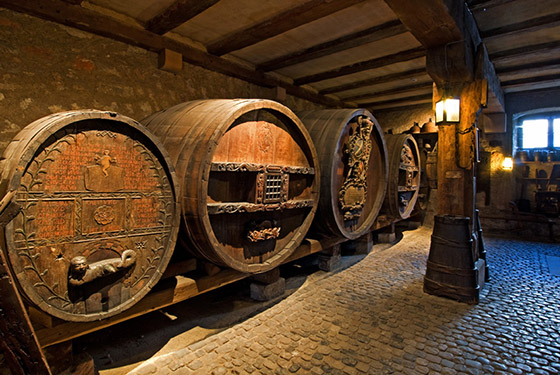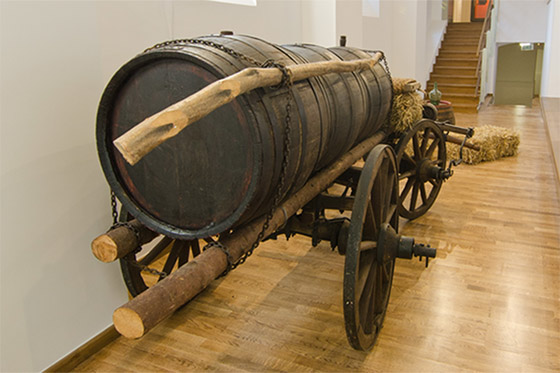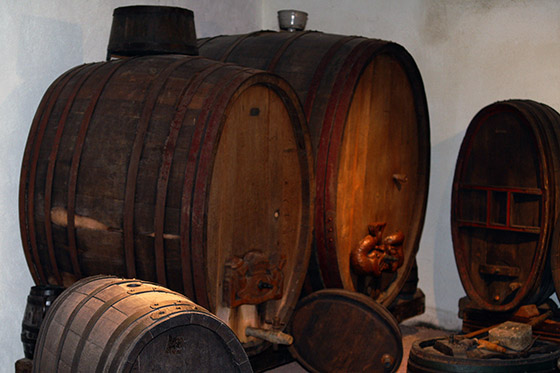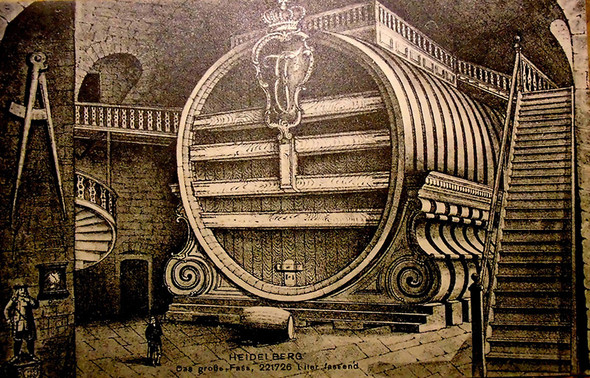You are new here? For the 2nd part of this article click here.
In addition to their storage function, right from their beginnings, there was a predilection for the use of wooden barrels because they added something extra to the wine. The pines the flavour of resin, the oak on the other hand... well, accounting for this is also difficult. To start with there is the tannin; this also helps a lot in the clarification process of the new wine, but can also have a positive influence on the evolution of the ‘velvetiness’ too. The oak aldehydes play a role in the creation of the wine’s aromas. Ageing in a toasted oak barrel also complements the wine’s flavours and aromas; the characteristic compounds are released from the staves and become part of the wine. (Certainly many people will surely have already felt strong vanilla notes in a red wine. Well, that’s a typical example of just this.) However, it’s important to note that the relationship between wine and wood is as complex and complicated as that between a father and son. The father continually wants to mould his son in his own image and if you don’t put a stop to this relationship in time, then he will definitely succeed too! Look at this like a school education. If it’s up to the father and the son continues the process for as long as daddy wants, the final result will be wine that is rough and undrinkable, in the best case, a perfect demonstration of the flavours of the barrel, but a child losing every individual and particular trait, just longing to be poured down the drain. Many wines, however, need this support; they need this maturation process. Their faults are too quickly hidden from ‘inspection’, thus simply enhancing their character. Although it’s sure that the wine decides, never the barrel! Like every child, each wine also has its own individuality and character which can’t and shouldn’t be forcibly moulded into anything else. A barrel can only have a positive influence on the ageing process if the wine actually needs it. In any other case, the end result is the same as the abovementioned father-son relationship. The forced rivalry will end up with someone coming off worse.

The most famous
The multitude of Hungary’s barrel types is surprising, so we will only list the most well known for now. There was the Abaúj, the Viennese, the Beregszász, the Berény, the Eger, the Transylvanian, the Gyöngyös, the Kosice, the Körmend, the Munkács, the Bratislava, the Somogy, the Sopron, the Szepes, the Szerém, the Sztankóc, the Telkibánya, the Tolna, the Ungvár, the Várad, and the large ‘Túlélő’, the Gönc barrel also achieving significant recognition abroad. The name Gönc was first seen towards the end of the sixteenth century. The barrel’s capacity changed greatly over the centuries, before ending up at today’s 135.75 litres. The other type of barrel known all around the world is not connected to any particular geographical location, but rather to the production method, although clearly a French invention. The Bordeaux barrique is ‘toasted’ or burnt to different colours for different amounts of time. Many flavour and aroma substances are assimilated into the wines stored in the standard 225 litre barrels. These barrels were already used by Hungarian wine merchants in the nineteenth century, although due to their high cost, this method then slumbered sweetly until it came back into fashion in the eighties. In the nineteenth century, a list of regions providing the best raw materials for barrels developed, that is to say wood for staves originating from Stettin and Gdansk near the Baltic Sea, the French Angoulème staves and Slavonic oak. The wood considered most suitable for barrique barrels is found mainly in France, for example Vosges, but American and even Hungarian raw materials are slowly making headway on the market. In Hungary, the Zempléni Hills, the Mecsek and the Drávamente principally provide the best quality wood for staves.

How much is enough?
The liquid capacities changed over thousands of years from town to town, indeed even the same name meant something completely different in the neighbouring village. The Romans used more than a dozen, whilst the German-speaking territories in the Middle Ages used more than half a dozen. However, for the wine trade there was a burning need for a uniform capacity measurement or for the establishment of an official capacity. This requirement brought into being the large so-called authentication houses established at commercial hubs. In Ulm, for example, there was already such an institution in operation from 1288, where two officials, the ‘authentication masters’, authenticated the barrels. They then entered the measured data and name of the barrel’s owner into the authentication book. The two measuring masters even measured the same barrel separately and if the data were different, then the middle proportional was final. The official capacity was then noted on the base of the barrel. Of course, a fee was also charged for the authentication. The first experiment for calculating the barrel capacity using maths was carried out by the famous scientist, Johannes Kepler. It’s amusing to imagine that as Kepler was establishing the law of planetary motion, he put optics into a revolutionary new light and then lay down in a wine barrel to relax. However, what actually happened is that he devoted a separate book to the matter, which saw the light of day in 1615 and bore the rotund title Nova stereometria doliorum vinariorum. (On the new volume of wine barrels). After a long break, the question came back into the limelight in the first half of the eighteenth century, thanks to J H Lambert. The renowned Swiss mathematician (at the same time, Kant’s correspondence partner) not only created permanence in the field of irrational numbers, but also developed its precise folding baton. (As a hobby. So you can see, that every great mathematician sooner or later lays anchor in a wine cellar...) With the help of the baton (what a surprise) the capacity was measured in a fold. This was taken to completion around 1867, when after a delay of 77 years, Hungarians also accepted the metric system. Nowadays, the National Measurement Authority manages these matters.

You can read more about a liquid history of barrels in the fourth part of this article.






